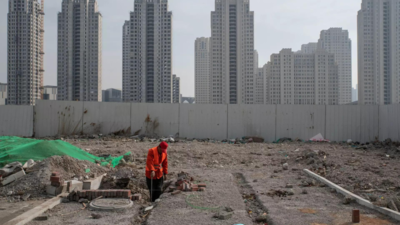- News
- World News
- China News
- 'Subsidence crisis: Nearly half of China’s major cities are sinking — some rapidly'
Trending
'Subsidence crisis: Nearly half of China’s major cities are sinking — some rapidly'
China faces severe land subsidence issues, affecting major cities like Beijing and Tianjin. The study warns that nearly a quarter of coastal lands could sink below sea level within the next century, posing significant threats to coastal areas.

A sidewalk under construction near new residential buildings in the Binhai district of Tianjin, China on March 3, 2023. (Photo/NYT News Service)
NEW DELHI: A recent study published in Science reveals alarming rates of land subsidence in China, with nearly half of the country's major cities experiencing significant sinking. This phenomenon poses a severe threat to China's coastal areas, with projections suggesting that up to one-quarter of these lands could slip below sea level within the next century.
The research, led by Tao Shengli of Peking University, utilized satellite radar pulses to assess elevation changes across 82 Chinese cities from 2015 to 2022.The findings indicate that some 16% of the area in these cities is sinking rapidly, by more than 10 millimeters per year, while approximately 45% is experiencing moderate subsidence. Notable cities like Beijing, Fuzhou, Hefei, and Xi'an are among those affected.
The northern city of Tianjin, which has a population exceeding 15 million, has been recognized as one of the most severely affected areas. Last year, a "sudden geological disaster" led to the evacuation of 3,000 residents, a situation that investigators attributed to water depletion and the drilling of geothermal wells.
"It really brings home that this is for China a national problem and not a problem in just one or two places," said Robert Nicholls at the Tyndall Centre for Climate Change Research at the University of East Anglia. "And it is a microcosm of what is happening around the rest of the world."
The study also points to successful mitigation efforts in places like Tokyo and Shanghai, where stringent regulations on groundwater extraction have significantly slowed subsidence rates. Tokyo, for instance, managed to reduce its subsidence from a rapid 240 mm annually in the 1960s to about 10 mm a year in the early 2000s by implementing strict groundwater pumping regulations. These examples suggest potential pathways for China to address its subsidence challenges.
As global sea levels rise due to climate change, the combination of sinking land and rising waters could result in severe flooding risks sooner than expected, exacerbating the challenges for coastal cities around the world.
(With inputs from agencies)
The research, led by Tao Shengli of Peking University, utilized satellite radar pulses to assess elevation changes across 82 Chinese cities from 2015 to 2022.The findings indicate that some 16% of the area in these cities is sinking rapidly, by more than 10 millimeters per year, while approximately 45% is experiencing moderate subsidence. Notable cities like Beijing, Fuzhou, Hefei, and Xi'an are among those affected.
The northern city of Tianjin, which has a population exceeding 15 million, has been recognized as one of the most severely affected areas. Last year, a "sudden geological disaster" led to the evacuation of 3,000 residents, a situation that investigators attributed to water depletion and the drilling of geothermal wells.
"It really brings home that this is for China a national problem and not a problem in just one or two places," said Robert Nicholls at the Tyndall Centre for Climate Change Research at the University of East Anglia. "And it is a microcosm of what is happening around the rest of the world."
Ding Xiaoli, a geodesist at the Hong Kong Polytechnic University, highlighted that subsidence is a global issue, not just confined to China. Factors contributing to the sinking include groundwater depletion, the weight of urban structures, and natural conditions like bedrock depth.
The study also points to successful mitigation efforts in places like Tokyo and Shanghai, where stringent regulations on groundwater extraction have significantly slowed subsidence rates. Tokyo, for instance, managed to reduce its subsidence from a rapid 240 mm annually in the 1960s to about 10 mm a year in the early 2000s by implementing strict groundwater pumping regulations. These examples suggest potential pathways for China to address its subsidence challenges.
As global sea levels rise due to climate change, the combination of sinking land and rising waters could result in severe flooding risks sooner than expected, exacerbating the challenges for coastal cities around the world.
(With inputs from agencies)
End of Article
FOLLOW US ON SOCIAL MEDIA











